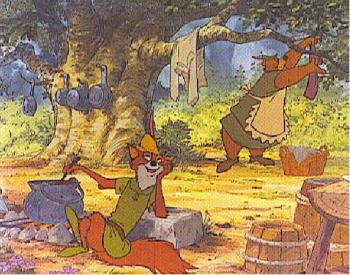Jim on Film
Page 3 of 6

(c) Disney
The re-use of animation comes to a pinnacle in Robin Hood. While this can be distracting to those who really know these films, the criticism can’t be taken too far. Animation is a costly process, and since the box office failure of Sleeping Beauty, the artists had needed to cut costs to keep Feature Animation successful. With a depleting department, concerns about finances, and the need to meet schedules because of the combination of those two, the animators probably resorted to this practice rather than choosing to do so out of laziness or lack of concern.
In addition to some reuse of animation, the audience is also asked to stretch their level of belief in a number of scenes, such as when Little John, in disguise as a fortune-teller, is able to empty the gold from the chest without the guards on both sides of him noticing. There are also continuity problems (likely from the extended production time due to depleting staff), such as fortune-teller Robin having shoes one moment and not the next. In animation, these sorts of issues always arise due to the process of filmmaking, but they seem quite obvious here.
These notations aside, Robin Hood also has a lot of creativity and fun to it. It’s hilarious when Lady Kluck takes to the field and dodges tackling rhinos, complete with animated backgrounds. The sword battle where Robin Hood and Maid Marion are discussing their future together while Robin Hood battles is hilarious and charming. The little turtle boy is very funny-something fresh and original. Like the other films of this time, there is a bounty of funny characters, whether it is Prince John beating on Sir His; Allan-a-Dale, the whistling rooster; or Lady Kluck, there’s a lot of fun to Robin Hood.
Visually, there’s a move toward the more refined Xerox line in Robin Hood, though, the strong presence of black lines around every character seems less appealing than it had previously. The backgrounds are also rich and beautifully painted with less use of the inked lines.
Also similar to most of the other films from this era, the emphasis is on comedy, rich characters, and great music. While Robin Hood is less successful than The Jungle Book in its weak plotting, its quality and entertainment value has been validated by its popularity and success.
With the majority of its contents being produced over a span of nine years, The Many Adventures of Winnie-the-Pooh provides an interesting perspective on its time. Within the film, one can follow the progression of the Xerox line through the character of Pooh who begins the film as a cuddly teddy bear and, in the final segment, appears a little less cuddly through a more refined line.
In many ways, to me, The Many Adventures of Winnie-the-Pooh signifies the power of animation. Children watching it will think it’s cute and fun but adults will enjoy it for its child-like sense of adventure and gently off-the-wall humor as well as the creativity of characters interacting with its storybook elements.
Like other films of this time, The Many Adventures of Winnie-the-Pooh does not rely on a strong plot to tell its story, instead depending on great characters, fun adventures, and great music to carry its audience though. And though it is essentially three stories combined to make one feature, the film never seems episodic. Much of this is aided by the touching conclusion in which Christopher Robin parts ways with his childhood, ending his adventures with Pooh on a poignant note. The Many of Adventures of Winnie-the-Pooh is a charming and wonderful film.
Transitional Period (1977-1988)
The Rescuers
marks a strong shift in the style of films. Unlike most of the films from the
Xerox Era, The Rescuers has a strong linear plot and strong dark
elements.
Visually, the Xerox lines are softer in nature, allowing the artists to render backgrounds that don’t depend on ink lines to mesh with the characters. There is still a Xerox influence in many of the backgrounds, with sketchy lines used to define shapes, but these lines are less prominent, and the scenes are filled with color, detail, and beauty. There is also a return to the increased use of multiplane effects, providing depth in some of the scenes.
Once again, The Rescuers is another step forward for the artists as the film is very different from what had been done before. While the films from the Xerox Era depended on humor and music, The Rescuers is stark and vastly different. What Medusa does to Penny is very disturbing, and there is very little humor to help defray that evil. There are no bumbling Baduns or three good fairies. Snoops is simple, but he’s more of a fool than comedic relief. This darkness is one of the strengths of the film because it increases the sympathy for Penny and her dreadful plight. It gives the film its heart.
